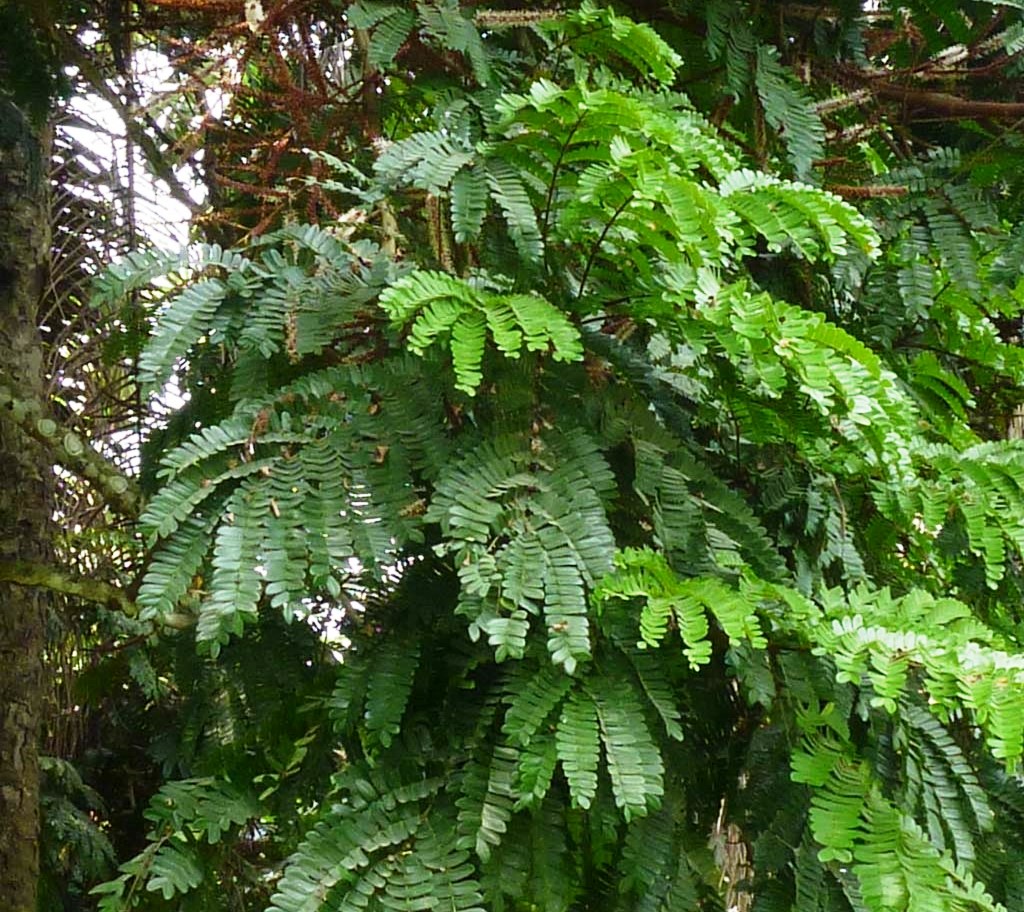Pentaclethra macrophylla

|
|
Pentaclethra macrophylla Common Names: African Oil Bean Tree, Owala Oil Tree,
Congo Acacia, Atta Bean Scientific
Classification Kingdom: Plantae Clade: Tracheophytes Clade: Angiosperms Clade: Eudicots Order: Fabales Family: Fabaceae Genus: Pentaclethra Species: P. macrophylla Authority: Benth. Synonyms: Pentaclethra filamentosa Benth., Pentaclethra macrophylla var. filamentosa (Benth.) Ducke, Pentaclethra guineensis A.Chev. Morphological Description Pentaclethra macrophylla is a large evergreen tree in the Fabaceae family, growing
15–40 m tall with a low-branching habit and an open, spreading crown up to 20 m
wide: · Stem: Gnarled bole, 0.3–2 m in diameter, with thick buttressed
roots and scaly brown bark (Fern, 2024). · Leaves: Bipinnate, 30–45 cm long, with 9–13 pairs of pinnae, each
bearing 8–14 pairs of rhombic leaflets, 1.2–2.5 cm long (Barwick, 2004). · Flowers: Small, creamy-white to yellowish, 1–2 cm long, in dense
racemes, strongly fragrant, blooming March–April (Burkill, 1995). · Fruit: Woody pod, 20–40 cm long, 5–10 cm wide, dark brown,
dehiscing explosively to release 4–8 glossy brown seeds (Fern, 2024). Distribution and Habitat Pentaclethra macrophylla is native to tropical West and Central Africa: · Range: Senegal to Angola, east to Sudan and Uganda; also on São
Tomé and Príncipe islands (Fern, 2024). · Habitat: Primary and secondary forests, riverbanks, coastal savannas;
thrives in 24–30°C, 1,500–2,500 mm rainfall, on loamy or clay soils (Burkill,
1995). Ethnopharmacology Pentaclethra macrophylla , commonly known as the African oil bean tree, is a plant
native to West and Central Africa, renowned for its extensive medicinal applications.
Traditionally, various parts of the plant have been utilized to address
ailments such as diabetes, diarrhea, toothache, fever, cough, and nausea.
Scientific investigations have corroborated several of these traditional uses,
revealing that extracts from the leaves, stem bark, seeds, and fruit pulp
exhibit anti-inflammatory, analgesic, antimicrobial, antioxidant, and
anthelmintic properties. Notably, the leaf extracts have demonstrated
significant antidiarrheal activity in experimental models, effectively reducing
fecal output and protecting against castor oil-induced diarrhea in rats.
Additionally, the plant has shown potential in wound healing, particularly in
diabetic conditions, with studies indicating that seed pod extracts promote
tissue regeneration. These therapeutic effects are attributed to the plant's
rich phytochemical composition, including alkaloids, saponins, flavonoids,
tannins, and essential fatty acids. While these findings underscore the
medicinal potential of Pentaclethra
macrophylla, further research is necessary to fully elucidate its
pharmacological properties and establish standardized therapeutic applications. · Topical Treatments: Bark decoction in Nigeria heals wounds;
use for leprosy sores. · Digestive Health: Leaf extracts in Cameroon treat diarrhea;
Akah et al. (1999) found ethanol extract (280 mg/kg) reduced diarrhea in rats
by 60%. · Anti-inflammatory: One study investigated the effects of
herbal lipospheres containing P.
macrophylla stem bark extract on inflammation and pain in rats. The results
indicated significant inhibition of inflammation in egg albumin-induced models
and reduced pain responses in formaldehyde-induced arthritis models (Nnamani et al., 2023). · Hepatoprotective: Ethanol bark extract significantly reduced
the serum level of ALAT, ASAT and TNF-α in d-galactosamine/LPS-induced
hepatitis in mice (Bomgning et al., 2021). · Nutritional: Seeds (20% protein, 46% oil) fermented into ugba; rich in
oleic (29%) and linoleic acids (54%) (Enujiugha & Akanbi, 2005). ⚠ Toxicity Profile: Raw seeds contain paucine (caffeoyl-putrescine),
toxic unless boiled 4–12 hours and fermented; high doses of leaf extract
(>770 mg/kg) caused liver damage in rats (Akah et al., 1999). Additional Uses · Culinary: Fermented seeds (ugba) used as condiment; seed oil (owala
butter) for cooking (Fern, 2024). · Industrial: Oil in candles, lubricants, soaps; wood for charcoal, poles
(Burkill, 1995). · Ecological: Nitrogen-fixing, fire-resistant, used in agroforestry for
shade and soil fertility (Fern, 2024). References
External Links More Pictures |
|
| Compounds of Pentaclethra macrophylla |
|
| References |